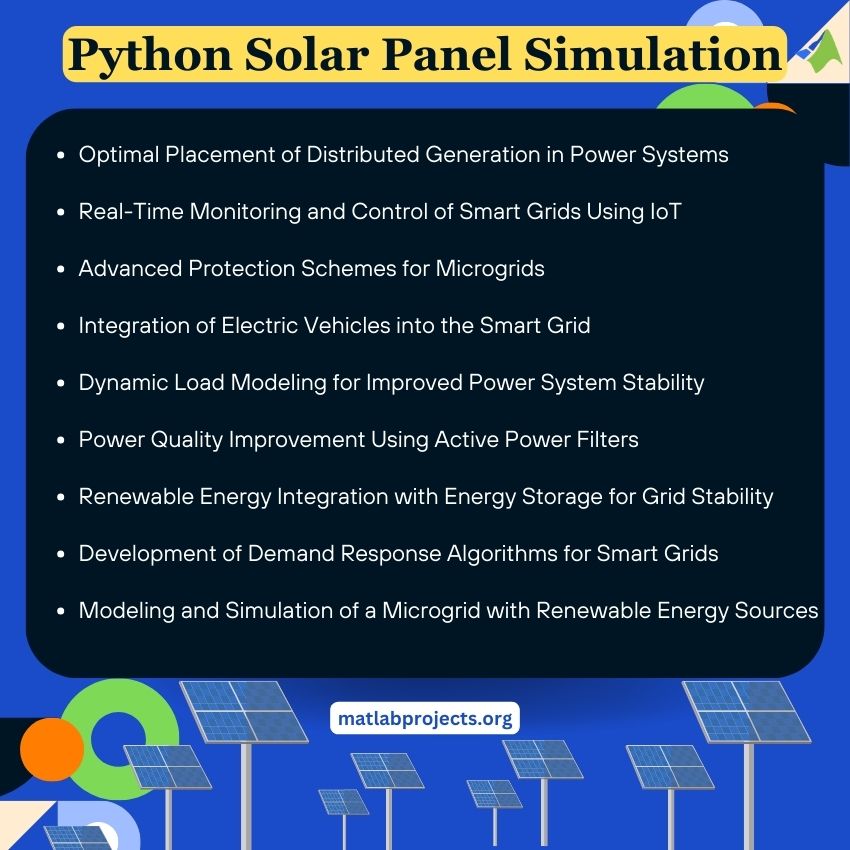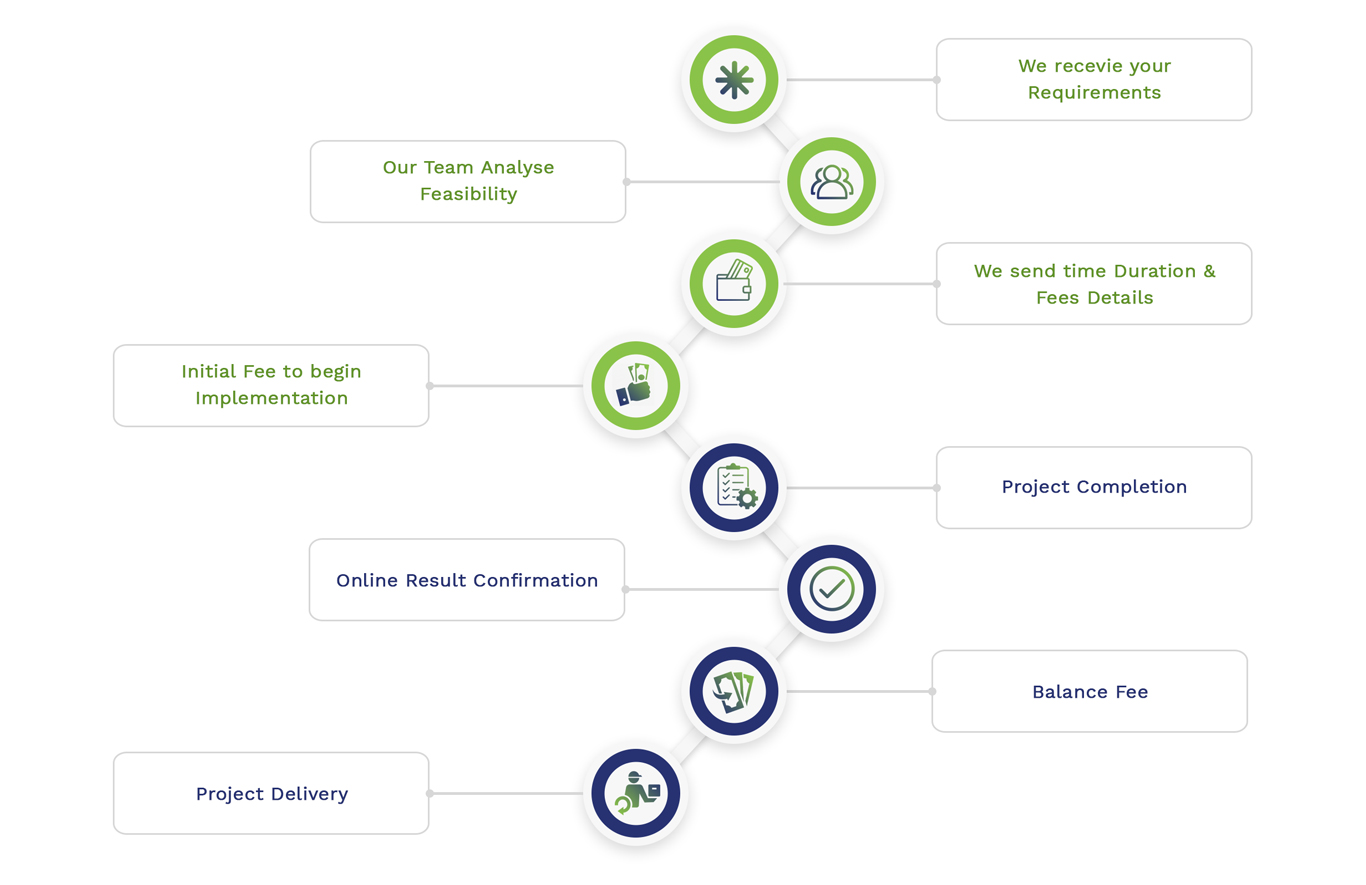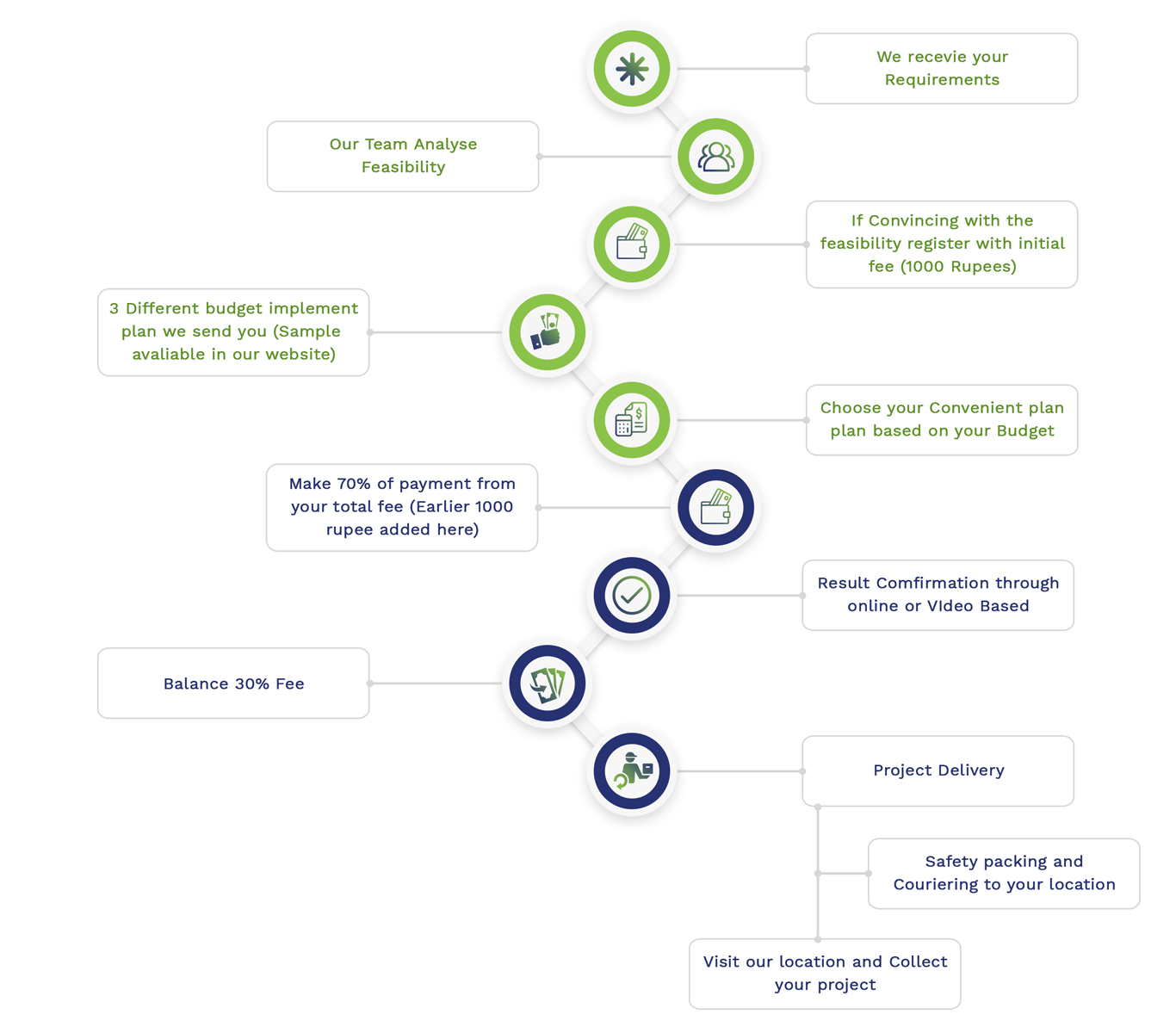Python Solar Panel Simulation and ideas that are existing in today’s world are shared by matlabprojects.org. Get best simulation, coding and implementation services for all your Python Solar Panel project from our leading developers. For solar panel simulation projects employing Python, we offer numerous intriguing and efficient topics and plans. A concise explanation, goals, and possible results are encompassed in every project plan:
- Simulation of Solar Panel Output under Varying Environmental Conditions
Goal: In various ecological situations like differing sunlight density, shading, and temperature, we plan to simulate the power output of a solar panel.
Major Elements:
- Output power calculation
- Solar panel system
- Ecological parameter inputs such as temperature, irradiance
Procedures:
- Model the Solar Panel: Through the utilization of parameters such as surface area, panel performance, and temperature coefficient, it is appreciable to develop a Python framework.
- Simulate Different Conditions: Typically, differing temperature and irradiance values have to be involved.
- Analyze Output: For various situations, our team assesses and plots the power output.
Anticipated Results:
- Interpretation based on how the effectiveness of the solar panel is impacted by ecological aspects could be offered.
- To simulate and visualize solar panel output under various settings, it could provide a Python script.
Tools: It is approachable to employ Python libraries like Pandas, NumPy, and Matplotlib.
Instance Code:
import numpy as np
import matplotlib.pyplot as plt
# Define solar panel parameters
efficiency = 0.17
area = 1.6 # in m^2
temp_coefficient = -0.004 # per degree Celsius
reference_temp = 25 # reference temperature in degrees Celsius
# Function to calculate power output
def calculate_power(irradiance, temp):
temp_factor = 1 + temp_coefficient * (temp – reference_temp)
power = efficiency * area * irradiance * temp_factor
return power
# Simulate for varying conditions
irradiance_values = np.linspace(200, 1000, 5) # in W/m^2
temp_values = np.linspace(0, 40, 5) # in degrees Celsius
# Plot results
for irradiance in irradiance_values:
power_output = [calculate_power(irradiance, temp) for temp in temp_values]
plt.plot(temp_values, power_output, label=f’Irradiance {irradiance} W/m^2′)
plt.xlabel(‘Temperature (°C)’)
plt.ylabel(‘Power Output (W)’)
plt.title(‘Solar Panel Power Output under Varying Conditions’)
plt.legend()
plt.show()
- Optimization of Solar Panel Tilt Angle for Maximum Energy Harvesting
Goal: To enhance energy gathering throughout a year, our team focuses on simulating and examining the efficient tilt direction for solar panels.
Major Elements:
- Sun path simulation
- Solar panel framework
- Tilt angle modification
Procedures:
- Model Solar Irradiance: On the basis of the position and time of year, it is significant to simulate solar irradiance.
- Calculate Energy Harvesting: We intend to combine the energy gathered across various tilt directions.
- Find Optimal Angle: The tilt direction which improves the energy output has to be detected.
Anticipated Results:
- It could provide perceptions based on the impact of tilt direction in solar energy gathering.
- For enhanced energy collection, it can offer a Python script which is capable of evaluating and visualizing the efficient tilt direction.
Tools: For sun position evaluation, focus on utilizing Python libraries like PyEphem and SciPy for enhancement.
Instance Code:
import numpy as np
from scipy.optimize import minimize
import matplotlib.pyplot as plt
# Define solar panel parameters
location_latitude = 35.0 # Latitude in degrees
location_longitude = -120.0 # Longitude in degrees
# Function to calculate irradiance based on tilt angle and location
def solar_irradiance(tilt_angle, day_of_year):
# Simplified model assuming max irradiance at noon
max_irradiance = 1000 # W/m^2
solar_declination = 23.45 * np.sin(np.radians(360 / 365 * (day_of_year – 81)))
solar_altitude = 90 – (location_latitude – solar_declination) – tilt_angle
if solar_altitude > 0:
irradiance = max_irradiance * np.sin(np.radians(solar_altitude))
else:
irradiance = 0
return irradiance
# Function to integrate energy over a year
def yearly_energy(tilt_angle):
total_energy = 0
for day in range(1, 366):
irradiance = solar_irradiance(tilt_angle, day)
total_energy += irradiance
return -total_energy # Negative for minimization
# Find the optimal tilt angle
result = minimize(yearly_energy, x0=[30], bounds=[(0, 90)])
optimal_tilt = result.x[0]
# Plot results
angles = np.linspace(0, 90, 100)
energies = [-yearly_energy(angle) for angle in angles]
plt.plot(angles, energies)
plt.xlabel(‘Tilt Angle (degrees)’)
plt.ylabel(‘Yearly Energy (kWh)’)
plt.title(‘Optimal Tilt Angle for Solar Panels’)
plt.axvline(optimal_tilt, color=’r’, linestyle=’–‘, label=f’Optimal Tilt: {optimal_tilt:.2f}°’)
plt.legend()
plt.show()
- Simulation of Solar Panel Degradation Over Time
Goal: It is appreciable to simulate the deprivation of solar panels periodically and its impact on power output.
Major Elements:
- Power output calculation over years
- Solar panel deprivation system
- Time-dependant effectiveness loss
Procedures:
- Model Degradation: Because of aspects such as UV elevation and weathering, simulate the performance loss by developing a suitable system.
- Calculate Long-Term Output: The power output has to be simulated over numerous years.
- Analyze Impact: Typically, on the generation of energy, our team plans to visualize the deprivation impact.
Anticipated Results:
- This project could offer an extensive interpretation of solar panel deprivation on how it influences the enduring generation of energy.
- To forecast the effectiveness of a solar panel periodically, it can contribute a Python script.
Tools: For plotting, it is beneficial to make use of Python libraries like Matplotlib and NumPy for calculations.
Instance Code:
import numpy as np
import matplotlib.pyplot as plt
# Define initial parameters
initial_efficiency = 0.17
degradation_rate = 0.005 # 0.5% per year
years = np.arange(1, 26) # Over 25 years
# Function to calculate efficiency over time
def efficiency_over_time(years, initial_efficiency, degradation_rate):
return initial_efficiency * (1 – degradation_rate) ** years
# Calculate efficiency over time
efficiency = efficiency_over_time(years, initial_efficiency, degradation_rate)
# Plot results
plt.plot(years, efficiency)
plt.xlabel(‘Years’)
plt.ylabel(‘Efficiency’)
plt.title(‘Solar Panel Efficiency Over Time’)
plt.grid(True)
plt.show()
- Simulation of a Solar-Powered Home Energy System
Goal: Encompassing load management and energy storage, our team aims to simulate the combination of solar panels into a home energy framework.
Major Elements:
- Household energy utilization system
- Solar panel array
- Battery storage
Procedures:
- Model Energy Production: Considering the real-life routine, simulate the generated solar energy.
- Model Energy Consumption: For household energy utilization, it is approachable to develop a system.
- Energy Storage and Management: The charging and discharging of batteries has to be simulated.
Anticipated Results:
- Valuable perceptions based on energy balance among creation and utilization could be offered.
- As a means to simulate energy flows and storage in a solar-based home, this project can contribute a Python framework.
Tools: Focus on utilizing Python libraries like Matplotlib for visualization, Pandas for data handling, and NumPy for calculation.
Instance Code:
import numpy as np
import pandas as pd
import matplotlib.pyplot as plt
# Define parameters
solar_power_peak = 5 # kW, peak solar power
battery_capacity = 10 # kWh
daily_energy_consumption = 15 # kWh
# Simulate solar power production (simplified)
hours = np.arange(24)
solar_power = solar_power_peak * np.sin(np.pi * hours / 24) ** 2
# Simulate energy consumption (simplified)
energy_consumption = daily_energy_consumption / 24 * np.ones(24)
# Calculate battery state of charge
battery_soc = np.zeros(24)
battery_soc[0] = battery_capacity / 2 # Start with half full battery
for i in range(1, 24):
battery_soc[i] = battery_soc[i-1] + solar_power[i] – energy_consumption[i]
battery_soc[i] = min(max(battery_soc[i], 0), battery_capacity) # Keep within bounds
# Plot results
plt.figure(figsize=(10, 5))
plt.plot(hours, solar_power, label=’Solar Power (kW)’)
plt.plot(hours, energy_consumption, label=’Energy Consumption (kW)’)
plt.plot(hours, battery_soc, label=’Battery SOC (kWh)’)
plt.xlabel(‘Hour of Day’)
plt.ylabel(‘Power / Energy’)
plt.title(‘Solar-Powered Home Energy System Simulation’)
plt.legend()
plt.grid(True)
plt.show()
- Design and Simulation of a Solar Tracking System
Goal: In order to enhance energy gathering, adapt the location of solar panels through simulating a solar tracking framework.
Major Elements:
- Tracking technology
- Solar panel system
- Sun position calculation
What should be an M Tech thesis topic in electrical engineering power system for a period of six months?
In the electrical engineering power system, many topics are progressing continuously. Together with a short explanation, possible aims, and anticipated results, we offer numerous significant and fascinating M Tech thesis topics which you could examine:
- Optimal Placement of Distributed Generation in Power Systems
Explanation: In order to decrease damages, enhance credibility, and improve voltage patterns, this topic includes the exploration and improvement based on the location of distributed generation (DG) units like small-scale gas turbines, solar panels, or wind turbines within a power distribution network.
Aims:
- Specifically, for the efficient location of DG units, we intend to construct and apply optimization methods.
- On voltage flexibility and power loss mitigation, it is approachable to assess the influence of DG.
Anticipated Outcomes:
- For efficient DG location, this project could contribute an extensive framework.
- In power distribution networks, it can provide several case analyses which can exhibit its enhanced capability and integrity.
Tools: PowerWorld simulator, MATLAB/Simulink, or ETAP.
- Real-Time Monitoring and Control of Smart Grids Using IoT
Explanation: Intending to improve performance, grid flexibility, and receptiveness, our study concentrates on combining an Internet of Things (IoT) mechanism into smart grid models mainly for actual-time tracking and management.
Aims:
- For actual-time tracking of power models, our team focuses on modeling an IoT-related system.
- Control policies have to be utilized for fault identification and demand response.
Anticipated Outcomes:
- Actual-time data collection and management could be depicted through a functional model.
- Typically, the abilities of enhanced grid management and fault response can be contributed.
Tools: Python, Arduino/Raspberry Pi, MATLAB.
- Advanced Protection Schemes for Microgrids
Explanation: Appropriate for microgrids, we create progressive protection plans that could function in grid-connected as well as islanded modes. It is for addressing problems like system flexibility, fault identification, and segregation.
Aims:
- For microgrids, our team intends to model and simulate protection methods in an efficient manner.
- Under different fault settings, it is approachable to assess the protection plans.
Anticipated Outcomes:
- In order to assure microgrid credibility, this project can offer powerful protection policies.
- Typically, efficient fault management is depicted by simulation outcomes.
Tools: DigSILENT PowerFactory, MATLAB/Simulink, and PSCAD.
- Integration of Electric Vehicles into the Smart Grid
Explanation: Concentrating on problems like load management, grid flexibility, and vehicle-to-grid (V2G) technology, this topic investigates the influence of combining electric vehicles (EVs) into the smart grid.
Aims:
- The combination of EVs has to be designed. It is significant to examine their influence on the grid.
- For load balancing and V2G communications, we construct suitable policies.
Anticipated Outcomes:
- On grid flexibility, it could offer perceptions into the impacts of EV combination.
- To improve grid effectiveness, this project can provide V2G policies.
Tools: HOMER, MATLAB/Simulink, and OpenDSS.
- Dynamic Load Modeling for Improved Power System Stability
Explanation: To forecast the activity of electrical loads under differing situations in an efficient way, we explore dynamic load modelling approaches. For improving system flexibility and scheduling, this is examined as significant.
Aims:
- As a means to imitate actual-world load activities, our team constructs dynamic load systems.
- On system flexibility studies, focus on assessing the influence of these systems.
Anticipated Outcomes:
- For various kinds of consumers, this project could provide precise load systems.
- Generally, enhanced flexibility analysis and scheduling can be contributed for power models.
Tools: PSS®E, MATLAB, PSCAD.
- Power Quality Improvement Using Active Power Filters
Explanation: In order to reduce power quality problems like voltage fluctuations, harmonics, and flicker in electrical power models, it is significant to concentrate on modelling and deploying active power filters (APFs).
Aims:
- In decreasing power quality problems, we focus on modelling APFs and simulating their effectiveness.
- As a means to improve the performance, our team intends to construct control policies for APFs.
Anticipated Outcomes:
- In power quality disruptions, this project could provide efficient mitigation.
- Enhanced power quality can be exhibited through simulation outcomes.
Tools: LabVIEW, MATLAB/Simulink, PSCAD.
- Renewable Energy Integration with Energy Storage for Grid Stability
Explanation: To improve grid credibility and flexibility, our team focuses on investigating the combination of renewable energy resources with energy storage models. It significantly balances the inconsistency of renewables.
Aims:
- It is appreciable to design and simulate the combination of renewable energy and energy storage.
- On grid flexibility, it is better to examine the influence. For an efficient combination, we intend to construct efficient policies.
Anticipated Outcomes:
- The advantages of energy storage in balancing renewable energy are demonstrated through systems and simulations.
- For combining renewable energy with least grid influence, it can provide beneficial instructions.
Tools: HOMER, MATLAB/Simulink, PSCAD.
- Development of Demand Response Algorithms for Smart Grids
Explanation: Concentrating on inhabitable or business customers, we model and deploy demand response methods to decrease high loads and enhance energy utilization in smart grids.
Aims:
- Focus on constructing and assessing demand response methods.
- On cost savings and energy performance, our team assesses the influence.
Anticipated Outcomes:
- As a means to decrease high requirements, this project could offer efficient demand response policies.
- It can provide analysis based on enhancements of grid effectiveness and energy savings.
Tools: Simulink, Python, MATLAB.
- Modeling and Simulation of a Microgrid with Renewable Energy Sources
Explanation: A microgrid combining renewable energy resources such as solar and wind has to be designed and simulated. Specifically, it is significant to concentrate on load balancing, flexibility, and energy management.
Aims:
- A microgrid with renewable energy combination has to be modelled.
- In various functioning situations, we intend to explore flexibility and effectiveness.
Anticipated Outcomes:
- Generally, for establishing efficient energy management, it could offer an extensive microgrid model.
- For the renewable combination, it could contribute perceptions on the basis of the approaches and limitations.
Tools: OpenDSS, MATLAB/Simulink, HOMER.
- Design and Analysis of High-Efficiency Power Converters for Renewable Energy Systems
Explanation: Intending to enhance the performance and credibility of energy conversion, our team concentrates on the model and analysis of high-performance power converters for renewable energy models.
Aims:
- With high credibility and performance, we plan to model power converters.
- Under different situations, it is appreciable to simulate and examine the effectiveness of these converters.
Anticipated Outcomes:
- Through this project we could provide high-performance power converter models.
- The advanced functionality of energy transmission can be exhibited through the simulation findings.
Tools: LTspice, MATLAB/Simulink, PLECS.

Python Solar Panel Simulation Topics & Ideas
Python Solar Panel Simulation Topics & Ideas, just a sample in which we completely aided for scholars are listed below. We have all leading resources and huge technical team support to provide novel assistance for all level scholars. Drop all your ideas we will provide you with original Solar Panel topics .All your research work will be kept highly confidential get plag free work from matlabprojects.org.
- Exhaustive Modal Analysis of Large-Scale Interconnected Power Systems with High Power Electronics Penetration
- A DC to 42.8 MHz Bandwidth Current Sensor Readout Interface using Amplifiers with Feedforward Compensation for Power Electronics Applications
- Role of Power Electronics in Primary Frequency Control and Power Quality in an Industrial Micro-grid Considering V2G Technology
- Robust stability analysis based on quadratic Lyapunov functions applied to power electronics
- A novel approach to the design and implementation of a power electronics simulation software package
- Hierarchical Weight Optimization Design of Aircraft Power Electronics Systems Using Metaheuristic Optimization Methods
- Modeling and Simulation of Electromagnetic Conducted Emission Due to Power Electronics Converters
- Coordinated Power Reserve Control of PV Sources For Frequency Restoration in Power Electronics Dominated Grid
- Hybrid Time and Event Co-simulation Framework for Power Electronics Systems
- Gas turbine-synchronous generator system emulation using power electronics converters
- Hardware-in-the-loop testing of high switching frequency power electronics converters
- Web-based software programmable e-learning platform for power electronics courses
- Electric Power Quality Indicators in a Company Producing Power Electronics
- Driving Innovations for Power Electronics with Integratable and Sustainable Magnetics
- Loss evaluation of aluminum electrolytic capacitor under power electronics converter excitation
- Efficient single-phase cooling techniques for durable power electronics module
- Design and Operation of a Cost-Effective Cooling Chamber for Testing Power Electronics at Cryogenic Temperatures
- Charaterization of Emerging Computing Architectures for Dynamic Simulation of Future Power Grids with Large-Scale Power Electronics
- Power electronics interfaces for low voltage distribution generation — EMC issues
- Modeling and Analysis of Harmonic Stability in an AC Power-Electronics-Based Power System
Subscribe Our Youtube Channel
You can Watch all Subjects Matlab & Simulink latest Innovative Project Results
Our services
We want to support Uncompromise Matlab service for all your Requirements Our Reseachers and Technical team keep update the technology for all subjects ,We assure We Meet out Your Needs.
Our Services
- Matlab Research Paper Help
- Matlab assignment help
- Matlab Project Help
- Matlab Homework Help
- Simulink assignment help
- Simulink Project Help
- Simulink Homework Help
- Matlab Research Paper Help
- NS3 Research Paper Help
- Omnet++ Research Paper Help
Our Benefits
- Customised Matlab Assignments
- Global Assignment Knowledge
- Best Assignment Writers
- Certified Matlab Trainers
- Experienced Matlab Developers
- Over 400k+ Satisfied Students
- Ontime support
- Best Price Guarantee
- Plagiarism Free Work
- Correct Citations
Expert Matlab services just 1-click

Delivery Materials
Unlimited support we offer you
For better understanding purpose we provide following Materials for all Kind of Research & Assignment & Homework service.
 Programs
Programs Designs
Designs Simulations
Simulations Results
Results Graphs
Graphs Result snapshot
Result snapshot Video Tutorial
Video Tutorial Instructions Profile
Instructions Profile  Sofware Install Guide
Sofware Install Guide Execution Guidance
Execution Guidance  Explanations
Explanations Implement Plan
Implement Plan
Matlab Projects
Matlab projects innovators has laid our steps in all dimension related to math works.Our concern support matlab projects for more than 10 years.Many Research scholars are benefited by our matlab projects service.We are trusted institution who supplies matlab projects for many universities and colleges.
Reasons to choose Matlab Projects .org???
Our Service are widely utilized by Research centers.More than 5000+ Projects & Thesis has been provided by us to Students & Research Scholars. All current mathworks software versions are being updated by us.
Our concern has provided the required solution for all the above mention technical problems required by clients with best Customer Support.
- Novel Idea
- Ontime Delivery
- Best Prices
- Unique Work
Simulation Projects Workflow

Embedded Projects Workflow



 Matlab
Matlab Simulink
Simulink NS3
NS3 OMNET++
OMNET++ COOJA
COOJA CONTIKI OS
CONTIKI OS NS2
NS2






